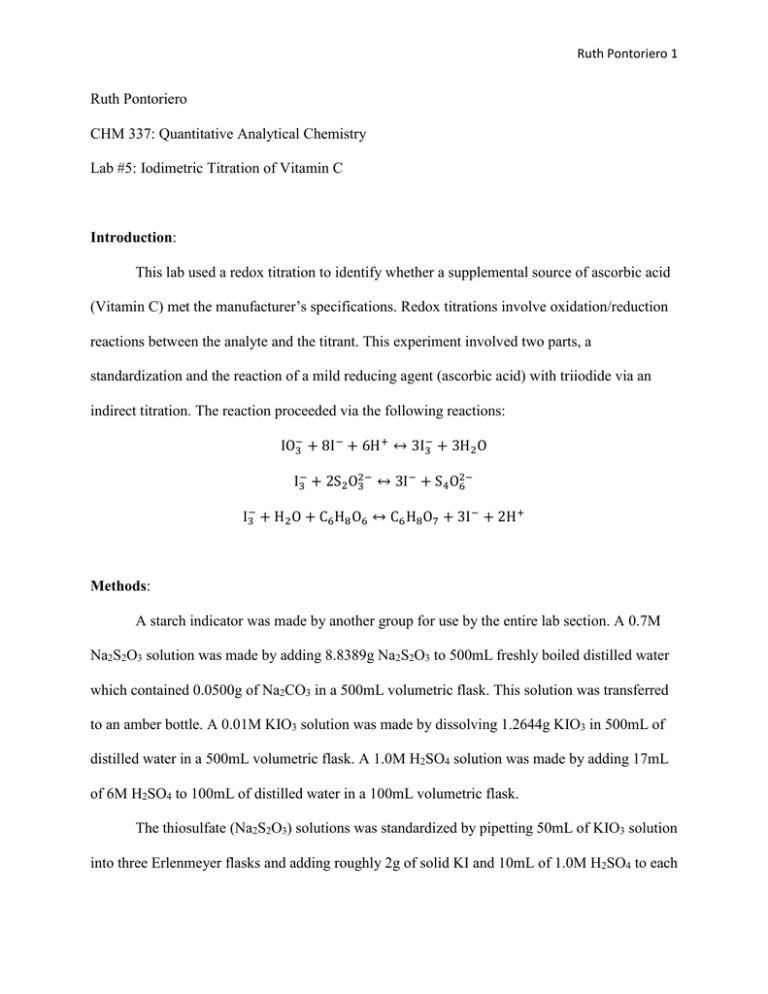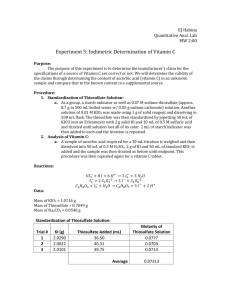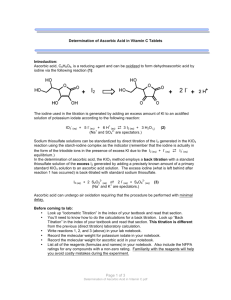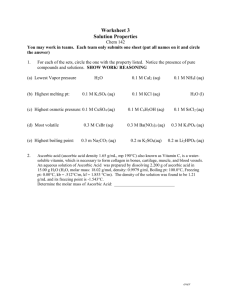Lab 5: Iodimetric Titration of Vitamin C
advertisement

Ruth Pontoriero 1 Ruth Pontoriero CHM 337: Quantitative Analytical Chemistry Lab #5: Iodimetric Titration of Vitamin C Introduction: This lab used a redox titration to identify whether a supplemental source of ascorbic acid (Vitamin C) met the manufacturer’s specifications. Redox titrations involve oxidation/reduction reactions between the analyte and the titrant. This experiment involved two parts, a standardization and the reaction of a mild reducing agent (ascorbic acid) with triiodide via an indirect titration. The reaction proceeded via the following reactions: − − + IO− 3 + 8I + 6H ↔ 3I3 + 3H2 O 2− − I3− + 2S2 O2− 3 ↔ 3I + S4 O6 I3− + H2 O + C6 H8 O6 ↔ C6 H8 O7 + 3I − + 2H + Methods: A starch indicator was made by another group for use by the entire lab section. A 0.7M Na2S2O3 solution was made by adding 8.8389g Na2S2O3 to 500mL freshly boiled distilled water which contained 0.0500g of Na2CO3 in a 500mL volumetric flask. This solution was transferred to an amber bottle. A 0.01M KIO3 solution was made by dissolving 1.2644g KIO3 in 500mL of distilled water in a 500mL volumetric flask. A 1.0M H2SO4 solution was made by adding 17mL of 6M H2SO4 to 100mL of distilled water in a 100mL volumetric flask. The thiosulfate (Na2S2O3) solutions was standardized by pipetting 50mL of KIO3 solution into three Erlenmeyer flasks and adding roughly 2g of solid KI and 10mL of 1.0M H2SO4 to each Ruth Pontoriero 2 flask. The samples were titrated using thiosulfate solution until dark yellow in color. At this point, 2mL of the starch indicator was added and the titration completed. This procedure was repeated for three trials. Three samples, each of roughly 0.062g of ascorbic acid, were each dissolved in 50mL of 1.0M H2SO4. Roughly 2g solid KI and 50mL KIO3 were added to each sample. Each sample was titrated using the procedure outlined above. This was repeated with all three samples. This procedure was repeated using three samples of roughly 0.081g of a crushed, commercial Vitamin C tablet instead of pure ascorbic acid. Results and Calculations: Standardization of thiosulfate Solid KI (g) Thiosulfate (mL) Trial #1 2.040 24.4 Ascorbic acid trials Trial #1 Solid KI (g) 2.0550 Ascorbic acid (g) 0.0696 Thiosulfate (mL) 25.9 Mean Thiosulfate (mL) Standard Deviation Thiosulfate (mL) Vitamin C trials Trial #1 Solid KI (g) 1.9905 Vitamin C tablet (g) 0.0969 Thiosulfate (mL) 25.8 Wt% ascorbic acid 87.7% Mean Thiosulfate (mL) Standard Deviation Thiosulfate (mL) Mean Wt% ascorbic acid Standard Deviation Wt% ascorbic acid Trial #2 2.001 24.3 Trial #3 1.993 24.1 Trial #2 2.0373 0.0663 25.0 25.6 ±0.493 Trial #3 1.9883 0.0791 25.8 Trial #2 2.0071 0.0960 24.8 88.5% 25.4 ±0.513 89.9% ±3.09% Trial #3 2.0108 0.0910 25.5 93.4% Ruth Pontoriero 3 Molarity of thiosulfate (Na2S2O3): 8.8389g Na2 S2 O3 1000mL 1mol Na2 S2 O3 ∗ ∗ = 0.10037M Na2 S2 O3 500mL H2 O 1L 176.12g Na2 S2 O3 Molarity of KIO3: 1.2644g KIO3 1000mL 1mol KIO3 ∗ ∗ = 0.011817M KIO3 500mL H2 O 1L 214.001g KIO3 Theoretical Mass Needed of Ascorbic Acid for 30mL titration: 30mL ∗ 1L 0.07mol Na2 S2 O3 1mol S2 O2− 1mol I3− 1mol KIO− 3 3 ∗ ∗ ∗ ∗ − 1000mL 1L 1mol Na2 S2 O3 2mol S2 O2− 3mol I 3 3 ∗ 1mol ascorbic acid 176.12g ascorbic acid ∗ = 0.062g ascorbic acid 1mol KIO− 1mol ascrobic acid 3 Actual Mass Needed of Ascorbic Acid for 30mL titration: 1L 0.10037mol Na2 S2 O3 1mol S2 O2− 1mol I3− 1mol KIO− 3 3 30mL ∗ ∗ ∗ ∗ ∗ − 2− 1000mL 1L 1mol Na2 S2 O3 2mol S2 O3 3mol I3 ∗ 1mol ascorbic acid 176.12g ascorbic acid ∗ = 0.088g ascorbic acid 1mol KIO3− 1mol ascrobic acid Theoretical Mass of Vitamin C tablet needed for 30mL titration: 0.5g ascorbic acid 0.062g ascorbic acid = → x = 0.081g tablet 0.6531g tablet x Actual Mass of Vitamin C tablet needed for 30mL titration: 0.5g ascorbic acid 0.088g ascorbic acid = → x = 0.11g tablet 0.6531g tablet x Ruth Pontoriero 4 Excess moles I3-: 1 mol S2 O3 2− 1 mol I3 − Molarity Na2 S2 O3 ∗ Volume Na2 S2 O3 ∗ ∗ 1 mol Na2 S2 O3 2 mol S2 O3 2− 0.10037mol Na2 S2 O3 1 mol S2 O3 2− 1 mol I3 − = ∗ 0.0258L Na2 S2 O3 ∗ ∗ 1L 1 mol Na2 S2 O3 2 mol S2 O3 2− = 0.00129mol I3− Initial moles I3-: 1mol I3− Molarity KIO3 ∗ Volume KIO3 ∗ 1mol KIO3 0.011817mol KIO3 3mol I3− = ∗ 0.050L KIO3 ∗ = 0.0017726mol I3− 1L 1mol KIO3 Moles I3-: initial moles I3− − excess moles I3− = 0.0017726mol − 0.00129mol = 0.00048mol I3− Mass of Ascorbic Acid: moles I3− ∗ 1mol ascorbic acid 176.12g ascorbic acid ∗ 1mol I3− 1mol ascorbic acid = 0.00048mol I3− ∗ 1mol ascorbic acid 176.12g ascorbic acid ∗ 1mol I3− 1mol ascorbic acid = 0.085g ascorbic acid Weight percent of ascorbic acid in tablet: wt% = mass ascorbic acid 0.085g ascorbic acid × 100% = ∗ 100% = 87.7% ascorbic acid mass tablet 0.0969g tablet Ruth Pontoriero 5 Discussion: The undissolved solid from the tablets was most likely the binding matrix used to bind the components into a solid tablet. The mean amount of Vitamin C in the tablet (89.9%) exceeded the manufacturer’s claim. Conclusion: In this experiment, the starch indicator could be added to the solution sooner to prevent over-titration, which occurred in the trials of several groups. This experiment seems like a fairly accurate method of determining the amount of Vitamin C contained in a commercially available tablet, as the values of ascorbic acid returned in each sample were comparable. In this reaction, the ascorbic acid acts as a reducing agent and is oxidized. The iodine acts as an oxidizing agent and is reduced.



